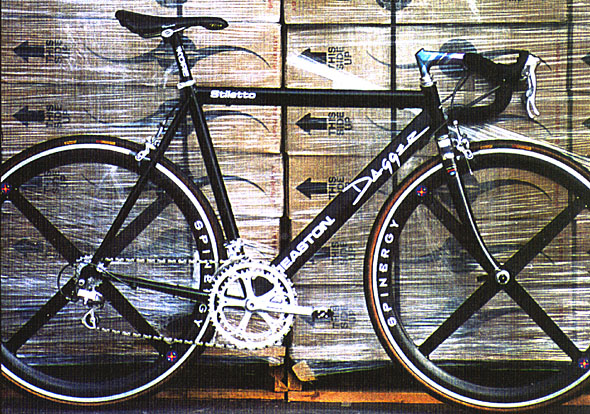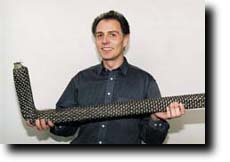
Sports Equipment
Easton launched the "Redline" in February 1997 as their
premier line of high performance baseball and softball bats using Ashurst's
scandium - aluminum alloy. The use of scandium - aluminum alloys have allowed
Easton to achieve strength increases that allow for the production of bats
with thinner walls, less weight, greater trampoline effect and enhanced
performance. The significantly refined grain size resulted in a strength
increase to 97 ksi (670 MPa) yield strength, for the conventional 7x7x
type aluminum alloy. Easton's international advertising and promotional
campaign for Redline included the use of these bats to win the world championship
softball competition this year.Sc500 is Easton's designation for the alloy
used for the aluminum shell in the Easton Redline. This change has been
called the most significant change in alloy design for a softball bat since
the introduction of C405 back in 1996. The composition for this alloy does
not fall exactly in the range for any of the common 7xxx alloys but is
most similar to 7055. The addition of Sc to Al in dilute quantities is
responsible for increased strength from Al3Sc precipitation,
enhanced weldability, and significant resistance to recrystallization.
Resistance to recrystallization means that Al alloys containing Sc will
have a finer and more consistent grain size retaining a higher degree of
"work" in the microstructure (higher dislocation content) after wrought
processing and heat treatment than comparable alloys without Sc. This translates
into significantly higher strengths and better overall properties than
for a comparable alloy without Sc. The effects of Sc are enhanced in the
presence of Zr due to the precipitation of fine Al3(ZrxSc1-x)
precipitates. Because this alloy contains both Sc and Zr it was obviously
developed to take advantage of this synergistic strengthening effect.

In September 1997, STX, the market leader in lacrosse stick sales, contracted for the delivery of several thousand lacrosse sticks made of an Ashurst scandium - aluminum alloy developed for greater strength and lower weight. Developments are also underway for scandium - aluminum tennis raquets and climbing equipment.
Ashurst GTA welding electrodes are commercially packaged with Easton's most advanced new mountain bike frame. This frame is made from a high strength weldable Al-Sc alloy and the welding filler rods are packaged with the frame components to help ensure the optimum bike performance. Tests have shown a three-fold increase in fatigue strength on these bike frames. Below is a picture of the Dagger's newest bike using Easton's frame.

Aerospace Applications
Daimler Benz Aerospace are considering the use of Sc-containing
Al-alloys in the new generations of Airbus airplanes. Combinations
of Al-Al3Sc composites and scandium - aluminum alloys are currently
being tested at Damiler Benz's research facilities. They hope to take advantage
of 7x7x wrought aluminum and aluminum-scandium products exceptional
as-extruded or drawn yield and tensile strength proven up to 100ksi (700
MPa). Shown below is a Al-Al3Sc composite tube.

Welding Wire
Advantages of aluminum welding wire with scandium addatice
are :
reduced hot cracking
reduced grain size
increased weld strength
The 5025 aluminum alloy designation from the Aluminum
Association has been reccomended for its welding filler metal products.
Gas Metal Arc (GMA) welding wire is available in various diameters and
1, 5 and 16 pound spools. Gas Tungsten Arc (GTA) welding rod is available
in various diameters as well. These products have met the quality certification
testing requirements of AWS A5.10. The 5025 welding filler
metal reduces hot cracking in many 7xxx alloys and is especially effective
when used in conjunction with weldable high strength Al-Sc alloys. The
5025 alloy also provides enhanced weld strength, especially in 7xxx series
alloys.

The superior welding capabilites of the 5025 allow are shown below in comparison to traditional aluminum welding (shown on left).


Additional Products
2% Sc master alloy ingot
Cast extrusion billets of Al-Sc alloys
Seamless tube of Al-Sc alloys
Extruded, drawn, or swaged product forms
Russian Al-Sc alloys
Listed below are some of the Al-Sc alloys that are currently
produced in Russia and exported.
Al-Mg-Sc alloys These alloys are in many ways equivalent
to the 5xxx series. In order to control the microstructure, they have small
additions of Sc, Zr, in some qualities also Ti, Mn, REM and other elements.
1515 - contains 1 % Mg, additions of Sc, Zr, and also
some REM
1523 - contains 2% Mg, otherwise as 1515 1535 - contains
4.5% Mg, otherwise as 1515
1570 - contains 6% Mg, additions of Sc, Zr, Mn, Be
1571 - contains 6% Mg. Special alloy for welding wire
Al-Zn-Mg-Sc alloys
This series of wrought, age hardenable and weldable alloys
are almost similar to the 7xxx series, except for the Sc addition.
1970 - Zr/Mg ratio of 2.6, typically 5%Zn and 1.7 Mg,
additions of Cu, Sc, Zr and Ti
1975 - Close to 1970, but lower Sc content (ca. 0.07%
Sc) 1981 - Close to AA7012, 1%Cu
1987 - Has superplastic properties Al-Mg-Li-Sc alloys
Age hardenable and weldable.
1421 - contains 5% Mg, 2%Li, 0.15%Sc, 0.17%Zr 1423 -
contains 3.5% Mg, otherwise as
1421 Al-Cu-Li-Sc alloys High strength and weldable. 1460
- contains 3%Cu, 2%Li, 0.1%Sc, 0.1%Zr